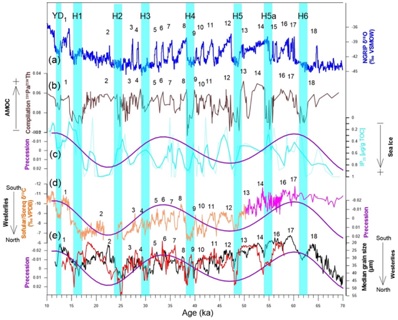
Mid-latitude Westerlies exert a huge influence on the global climate by modulating the transport and distribution of momentum, heat, and moisture. In particular, position and intensity of the northern westerlies reshape hydrological climate in mid-latitudes. However, climatic variations and forcing mechanisms of the westerly variabilities are still enigmatic.
Recently, a research group for Central Asian loess led by Prof. SONG Yougui from the Institute of Earth Environment (IEE), Chinese Academy of Sciences, presented a latitudinal-shift history of the northern westerlies in the past 70,000 years based on two eolian loess sections in eastern Central Asia. They also investigated the physical mechanisms of millennial- and orbital-scale variations of the westerlies with two sensitivity experiments and a transient simulation.
The group took grain size as an index to reveal the latitudinal shift of the westerlies in various timescales. With the reliable optically stimulated luminescence (OSL) dating results, they found that migration of the westerlies at the millennial-scale corresponded well to the abrupt climatic change events in the North Atlantic (H1-H6 andDO 1–18) (Fig.1).
At the orbital time scale, a northward shift of the westerlies over Central Asia followed well larger precession index. Based on the TraCE-21 ka transient simulation and sensitivity experiments in the LOVECLIM and CCSM3 models, the group further examined the physical mechanisms of variations of the northern mid-latitude westerlies.
The results showed that the slowdown of the Atlantic meridional overturning circulation (AMOC) deceased temperatures in the high-latitude of Northern Hemisphere, leading to an increase in the meridional temperature gradient and a northward displacement of the westerlies in the mid-latitudes at 500 hPa. While, the orbital time scale, variations in winter (summer for pole region) insolation caused by precession led to latitudinal temperature gradient changes, which also simulated a displacement of the westerlies.
This work, published in Climate Dynamics, opens a detailed picture on the mid-westerlies variability in Central Asia, and expounds the forcing mechanisms of changes in mid-westerlies at different timescales. These findings are helpful to understand future climate change in Central Asia.
This work was supported by the National Natural Science Foundation of China and the Fonds de la Recherche Scientifque-FNRS.

Fig. 1 The last glacial data comparisona. NGRIP δ18O (blue), b AMOC proxy (brown), c Sea ice (cyan), d Sofular/Soreq δ13C (orange/pink), and e Median grain size of Tacheng and Yumin (black and red, this study), and the precession (purple). Sky-blue bars denote the Heinrich-like events identified in the six records. Black numbers (1–18, 10–70 kyr) denote well aligned DO events identified in the four records. (Image by LI Yun et. al)

86-10-68597521 (day)
86-10-68597289 (night)

52 Sanlihe Rd., Xicheng District,
Beijing, China (100864)

